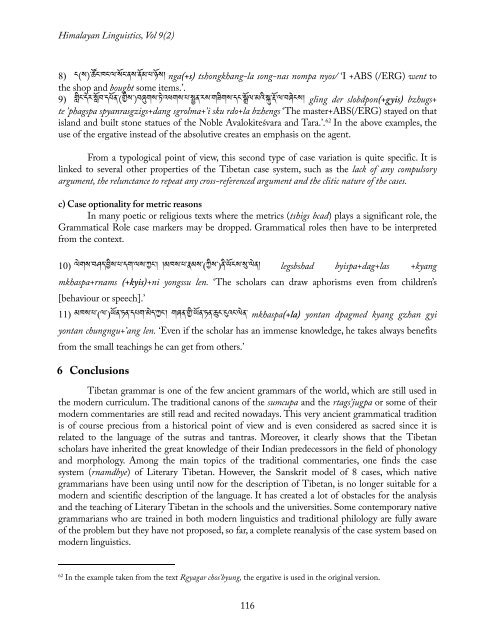The Classical Tibetan cases and their transcategoriality
The Classical Tibetan cases and their transcategoriality
The Classical Tibetan cases and their transcategoriality
Create successful ePaper yourself
Turn your PDF publications into a flip-book with our unique Google optimized e-Paper software.
Himalayan Linguistics, Vol 9(2)<br />
8) ང(ས)་ཚོང་ཁང་ལ་སོང་ནས་ནོམ་པ་ཉོས། nga(+s) tshongkhang-la song-nas nompa nyos/ ‘I +ABS (/ERG) went to<br />
the shop <strong>and</strong> bought some items.’.<br />
9) གླིང་དེར་སློབ་དཔོན་(གྱིས་)བཞུགས་ཏེ་འཕགས་པ་སྤྱན་རས་གཟིགས་དང་སྒྲོལ་མའི་སྐུ་རྡོ་ལ་བཞེངས། gling der slobdpon(+gyis) bzhugs+<br />
te ’phagspa spyanrasgzigs+dang sgrolma+’i sku rdo+la bzhengs ‘<strong>The</strong> master+ABS(/ERG) stayed on that<br />
isl<strong>and</strong> <strong>and</strong> built stone statues of the Noble Avalokiteśvara <strong>and</strong> Tara.’. 62 In the above examples, the<br />
use of the ergative instead of the absolutive creates an emphasis on the agent.<br />
From a typological point of view, this second type of case variation is quite specific. It is<br />
linked to several other properties of the <strong>Tibetan</strong> case system, such as the lack of any compulsory<br />
argument, the relunctance to repeat any cross-referenced argument <strong>and</strong> the clitic nature of the <strong>cases</strong>.<br />
c) Case optionality for metric reasons<br />
In many poetic or religious texts where the metrics (tshigs bcad) plays a significant role, the<br />
Grammatical Role case markers may be dropped. Grammatical roles then have to be interpreted<br />
from the context.<br />
10) ལེགས་བཤད་བྱིས་པ་དག་ལས་ཀྱང་། །མཁས་པ་རྣམས་(ཀྱིས་)ནི་ཡོངས་སུ་ལེན། legsbshad byispa+dag+las +kyang<br />
mkhaspa+rnams (+kyis)+ni yongssu len. ‘<strong>The</strong> scholars can draw aphorisms even from children’s<br />
[behaviour or speech].’<br />
11) མཁས་པ་(ལ་)ཡོན་ཏན་དཔག་མེད་ཀྱང་། གཞན་གྱི་ཡོན་ཏན་ཆུང་ངུའང་ལེན་ mkhaspa(+la) yontan dpagmed kyang gzhan gyi<br />
yontan chungngu+’ang len. ‘Even if the scholar has an immense knowledge, he takes always benefits<br />
from the small teachings he can get from others.’<br />
6 Conclusions<br />
<strong>Tibetan</strong> grammar is one of the few ancient grammars of the world, which are still used in<br />
the modern curriculum. <strong>The</strong> traditional canons of the sumcupa <strong>and</strong> the rtags’jugpa or some of <strong>their</strong><br />
modern commentaries are still read <strong>and</strong> recited nowadays. This very ancient grammatical tradition<br />
is of course precious from a historical point of view <strong>and</strong> is even considered as sacred since it is<br />
related to the language of the sutras <strong>and</strong> tantras. Moreover, it clearly shows that the <strong>Tibetan</strong><br />
scholars have inherited the great knowledge of <strong>their</strong> Indian predecessors in the field of phonology<br />
<strong>and</strong> morphology. Among the main topics of the traditional commentaries, one finds the case<br />
system (rnamdbye) of Literary <strong>Tibetan</strong>. However, the Sanskrit model of 8 <strong>cases</strong>, which native<br />
grammarians have been using until now for the description of <strong>Tibetan</strong>, is no longer suitable for a<br />
modern <strong>and</strong> scientific description of the language. It has created a lot of obstacles for the analysis<br />
<strong>and</strong> the teaching of Literary <strong>Tibetan</strong> in the schools <strong>and</strong> the universities. Some contemporary native<br />
grammarians who are trained in both modern linguistics <strong>and</strong> traditional philology are fully aware<br />
of the problem but they have not proposed, so far, a complete reanalysis of the case system based on<br />
modern linguistics.<br />
62 In the example taken from the text Rgyagar chos’byung, the ergative is used in the original version.<br />
116
















